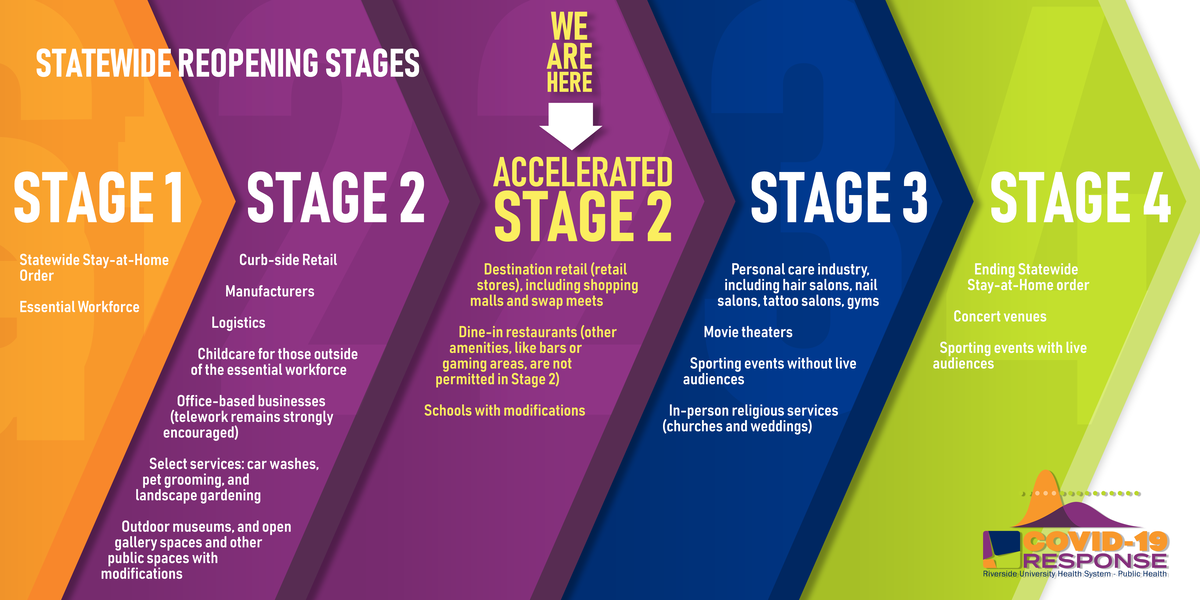CA approves Riverside County to reopen malls, dine-in restaurants
Effective immediately, Riverside County will be allowed to reopen more businesses, including shopping malls and dining restaurants.

The state of California approved Riverside County's request to move into accelerated stage 2 reopening. There will be several modifications to how these businesses operate in order to protect patrons and staff.
Schools are apart of stage 2, however, the Riverside County board of supervisors voted to extend the closure of K-12 schools until June 15, so those schools will remain closed.
Individual cities can choose to keep these businesses closed. Cities will more than likely make announcements in the next coming days. Stay with News Channel 3 for updates.
The following businessses and services remain closed:
- Personal services such as hair and nail salons, tattoo parlors, gyms and fitness studios
- Hospitality services, such as bars, wineries, tasting rooms and lounges
- Entertainment venues, such as movie theaters, gaming, gambling, arcade venues, pro sports, indoor museums, gallery spaces, and zoos
- Community centers, public pools, playgrounds, and picnic areas
- Religious services and cultural ceremonies
- Nightclubs
- Concert venues
- Live audience sports
- Festivals
- Theme parks
- Hotels/lodging for leisure and tourism
Newsom said guidelines to reopen religious services could possibly be released as early as Monday. He also said today that the state is days away from modifications for salons.
Newsom added that the order for gatherings may be modified soon
Read the full guidelines for dine-in restaurants here
Read the full guidelines for retails shopping here
Guidelines for dine-in restaurants:
- Establishing a workplace-specific plan to prevent coronavirus spread
- Employee training, including how to self-screen at home and proper steps to prevent the spread of coronavirus
- Provide temperature and/or symptom screenings for all workers at the beginning of their shift and any vendors, contractors, or other workers entering the establishment
- Frequent cleaning and disinfecting
- Frequently clean items touched by patrons, especially those that might attract contact from children
- Clean touchable surfaces between shifts or between user
- Equip spaces such as dining rooms, bar areas, host stands, and kitchens with proper sanitation products
- Restaurants should increase fresh air circulation by opening windows or doors, if possible to do so.
- Provide disposable menus to guests and make menus available digitally
- Suspend the use of shared food items such as condiment bottles, salt, and pepper shakers, etc. and provide these foods in single-serve containers
- Pre-roll utensils in napkins prior to use by customers
- Establish physical distance guidelines
- Prioritize outdoor seating and curbside pickup to minimize cross flow of customers in enclosed environments
- Encourage reservations to allow for time to disinfect restaurant areas
- Ask customers to wait in their cars or away from the establishment while waiting to be seated
- Reconfigure office spaces, lobbies, beverage bars, kitchens and workstations, host stand areas, and other spaces wherever possible to allow for at least six feet of distance between people dining, working, and passing through areas for entry and exit.
- Bar areas should remain closed to customers.
- Face coverings are strongly encouraged for all employees, however, they are required for any employee (e.g., server, manager, busser, food runner, etc.) who must be within six feet of customers
- Guests should enter through doors that are propped open or automated, if possible. Hand sanitizer should be available for guests who must touch door handles
- Display a set of clearly visible rules for customers and restaurant personnel at the restaurant entrance(s) that are to be a condition of entry.
- The rules could include instructions to use hand sanitizer, maintain physical distance from other customers, avoid unnecessary touching of restaurant surfaces, contact information for the local health department, and changes to restaurant services. Whenever possible, the rules should be available digitally, include pictograms, and included on/with menus
- Guests and visitors should be screened for symptoms upon arrival, asked to use hand sanitizer, and to bring and wear a face covering when not eating or drinking.
- Licensed restaurants may sell “to-go” alcoholic beverages, prepared drinks, and pre-mixed cocktails provided they are sold and delivered to customers in conjunction with the sale and delivery of a meal/meals.
Key prevention practices include:
- Physical distancing to the maximum extent possible,
- Use of face coverings by employees (where respiratory protection is not required) and customers/clients,
- Frequent handwashing and regular cleaning and disinfection,
- Training employees on these and other elements of the COVID-19 prevention plan



